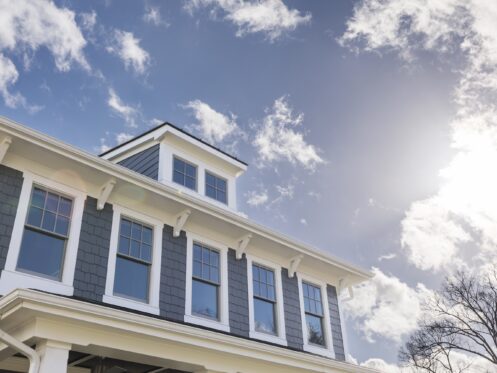It’s easy to forget your roof when troubleshooting high cooling bills, but the color and material up top might be working against you. At Environmental Heating & Air Solutions, located in Northern California, we help homeowners choose reflective roofing options that bounce sunlight away and keep their interiors cooler. When your roof works smarter, your home feels comfortable without having to crank down your thermostat.
The Role of Color and Texture in Heat Bounce-Back
Your roof takes the full brunt of the sun each day, especially in hot, sunny climates like California. The type of roofing material and its surface color or coating plays a major role in how much solar energy is absorbed versus reflected.
Traditional dark-colored shingles tend to absorb a significant amount of radiant heat, which is then conducted into the attic. Once inside, this trapped heat can spread downward into your home, raising indoor temperatures and forcing your air conditioner to work harder.
When you install a reflective or “cool” roof, the surface is engineered to reflect more of the sun’s energy and absorb less heat. These roofs are often made with special coatings, light-colored granules, or reflective materials like metal or white membrane systems. This high reflectivity helps keep the roof surface cooler by up to 50 to 60°F compared to conventional dark roofs on a sunny day. As a result, less heat makes it into the attic space, which keeps your upper floors more comfortable and may significantly reduce your cooling bills.
Airflow Beneath the Roof Impacts Results
Even the most reflective roofing materials can only do so much if the heat beneath the roofline has nowhere to go. That’s where attic ventilation comes in. When warm air builds up inside the attic, it needs a way to escape. Without proper airflow, this trapped heat lingers, radiates downward, and reduces the effectiveness of your reflective roof. A cool roof works best when it’s paired with a well-ventilated attic.
An efficient attic ventilation system includes both intake vents (typically installed near the eaves or soffits) and exhaust vents (usually near the roof ridge). This creates a continuous flow of air that allows rising heat to escape. Without this circulation path, hot air gets stuck in the attic, contributing to “heat soak,” which is when attic temperatures remain high long after the sun has gone down.
In some cases, attic fans or solar-powered ventilators can provide an additional boost, especially in homes where passive ventilation is limited. These systems actively pull hot air out of the attic, speeding up the cooling process and reducing the strain on your air conditioning system. If your attic feels stuffy or you don’t notice any airflow on a hot day, it may be time to evaluate your ventilation system.
Roof Age Can Change Its Reflective Value
A brand-new reflective roof works much differently than one that has been exposed for ten summers. Over time, dirt accumulates, and UV exposure can cause the reflective coating to dull. Even hail or wind-borne grit can roughen the surface. A roof that once reflected 70 percent of solar radiation might only reflect 50 percent after years of exposure.
Regular professional maintenance can help preserve the reflective qualities of the material. Washing off debris and inspecting for coating damage can help restore the roof to its intended performance. Some reflective roofs allow for recoating. That option extends the lifespan of the surface and helps it maintain high reflectivity through many summers.
Reflective Coatings Work on Flat Roofs Too
If your home has a flat or low-slope roof, you might think reflective roofing isn’t an option. However, reflective coatings can be applied easily to flat surfaces, especially those made from materials like TPO, EPDM, or modified bitumen. These coatings roll on like thick paint, creating a surface that reflects sunlight without altering the structure below.
Reflective coating also reduces stress on seals and limits thermal expansion across flat panels. You’ll still want to clean the surface regularly since a dusty roof reflects less light than a clean one.
Savings Go Beyond Energy Bills
Lower cooling costs get most of the attention, but reflective roofing also slows down structural fatigue. Heat cycles cause roofing materials to expand and contract. The wider the temperature swing, the harder that motion pulls at the fasteners and seals. Reflective roofing cuts the top range of that swing. With less expansion pressure, your shingles or membrane hold tighter to the deck.
That slower wear and tear helps avoid cracked sealants, popped nails, or warped flashing. You will also reduce the chances of leaks forming during a summer thunderstorm.
Reflective Roofing and Single-Story Homes
In single-story homes, attic insulation and reflective roofing play an especially important role in keeping indoor temperatures stable. With no second floor to buffer the heat, the living spaces sit directly beneath the attic, which means radiant heat from above transfers more easily through the ceiling. Without a well-insulated attic floor, that heat can seep down into your home, making cooling less efficient and comfort harder to maintain, especially in the afternoon and early evening when attic temperatures peak.
When a reflective roof is combined with proper attic insulation, it forms a powerful thermal barrier. This helps maintain more consistent indoor temperatures and reduces strain on your air conditioning system. Kitchens, in particular, are often the hardest rooms to keep cool because of the heat generated from cooking, using the oven, and running the dishwasher. Laundry rooms also tend to run warm due to heat and moisture from appliances. With better roof performance and attic insulation, these heat-prone areas stay more comfortable, and your home runs more efficiently overall.
A Reflective Roof Supports Solar Panel Performance
If you’re considering solar panels, pairing them with a reflective roof can increase their efficiency and longevity. Reflective roofing reduces surface temperatures, which helps solar panels stay cooler and operate more efficiently. That’s because photovoltaic (PV) cells lose performance as they heat up.
Keeping them cooler helps preserve their energy output on sunny days. Reflective roofing is also beneficial for solar installation. Cooler roof surfaces experience less expansion and contraction, which puts less stress on the mounting hardware and helps maintain a watertight seal around attachment points.
Even Small Changes Can Help
You don’t need to install reflective material across your entire roof to see energy-saving benefits. Even small changes, such as applying reflective coatings to specific sections, can reduce heat buildup. West-facing slopes and flat roof areas typically absorb the most sun and retain heat longer, making them ideal spots for targeted improvements.
These partial improvements are not as good as a full roof replacement. However, they can help reduce indoor temperatures and stretch the life of your existing roof while you plan for long-term updates.
Consider Reflective Roofing for Your Next Project
Whether you’re building a new home or upgrading an existing roof, it’s worth choosing materials that actively contribute to energy savings. Reflective roofing can help lower your cooling costs, protect your home from heat buildup, and improve indoor comfort. If you’re ready to reduce energy use from the top down, contact Environmental Heating & Air Solutions to explore your roofing options.
We also offer building automation, energy management, and HVAC services to help you maximize efficiency across your entire Northern California home.

